Metro Manila is, by its very nature, a city vulnerable to flooding. Yet it has grown and developed into a monstrous megalopolis that, today, teeters on the brink of catastrophic failure. Manila is bisected by the Pasig River into which connect a system of natural waterways that both feed into it and absorb excess water in times of heavy water flow (say, brought about by heavy rains). The following 1898 map of Manila shows how these waterways weave through much of the city in the immediate vicinities of the Pasig…
[Following two photos courtesy Erick Quinto]
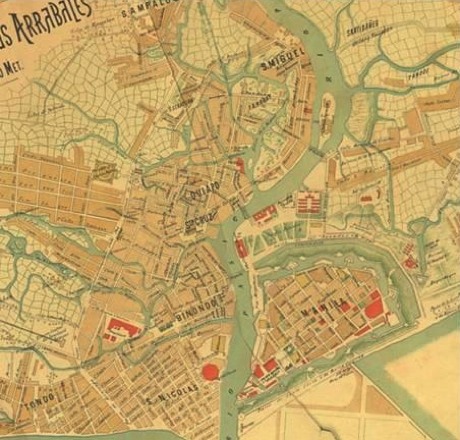
| SUPPORT INDEPENDENT SOCIAL COMMENTARY! Subscribe to our Substack community GRP Insider to receive by email our in-depth free weekly newsletter. Subscribe to our Substack newsletter, GRP Insider! Learn more |
Many of these natural waterways don’t seem to be visible in the following modern aerial photo of the same area in Manila. They may have been built over or been narrowed to the standard width of a street and therefore obscured from view.
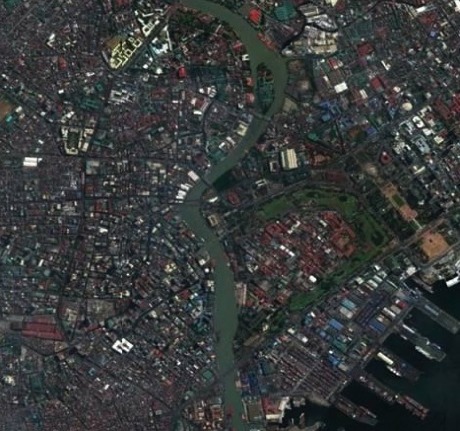
Much of the forests that once covered highlands from which water that feeds Manila’s river systems originates once served as the lowlands’ first line of protection from torrential water flow into the low-lying rivers and waterway systems. With that forest cover gone, Manila would have benefited greatly had its natural river system channels still been intact today — perhaps, had city planners applied a bit of foresight, these might even have been enhanced and even turned into key features of the city.
A city the size of Manila therefore cannot be protected against flooding but could be designed to live with it. This, in fact, is the thesis of a group of innovative architecture firms who propose applying a ‘soft architecture’ approach to protect New York City from the next big storm (NB: the following two images are sourced from that article)…
“In lieu of a literal wall around lower Manhattan, which would cost millions of dollars but would only perform in a flood, we proposed an ecological infrastructure that would allow water in and out of lower Manhattan,” [Adam Yarinsky, principle of the Architecture Research Office (ARO)] says. “We’re thinking about a continuum of land and water.”

In order to do this, islands and marshes would be constructed along the edges of the city to diminish the force of storm surges, and streets would have porous pavement which would prevent the city from shutting down in the event of a flood. Gas, electric, sewage, water infrastructure would be relocated to waterproof vaults beneath the sidewalk. Roads and buildings would be renovated in order to have more greenery for absorbing and storing rainwater.
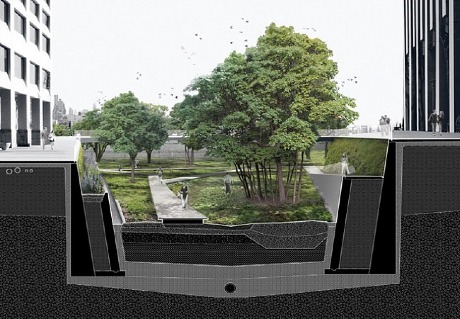
At the moment, the challenges that face Manila residents’ efforts to see permanent solutions to flooding and an acceptable state of preparedness for disasters implemented within their lifetimes are formidable. Among these are the obvious vulnerability of inhabitants (many of them “informal settlers”) of residential areas built on flood plains and low-lying coastal areas…
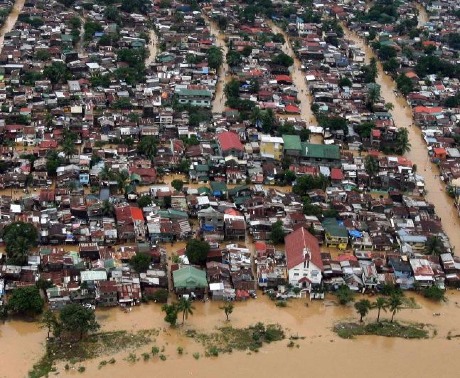
[Photo courtesy AlertNet.]
…and the rather laissez-faire attitude Manila residents apply to garbage disposal which came back to bite with a vengeance…
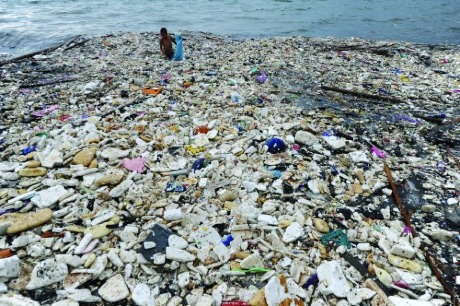
[Photo courtesy MacauDailyTimes.com.mo.]
Suffice to say, politics Pinoy-style, will likely be more of a hindrance than a catalyst for the rolling out of solutions across what is really a a broad and profound system of factorsthat contribute to flooding that Metro Manila desperately requires. For now, Filipinos can only pray.
benign0 is the Webmaster of GetRealPhilippines.com.
You think Manila is unique with problem of Flood Water?
Check out the problem of Kuala Lumpur, before they tacked it, al;ong with better solution to Traffic Congestion.
Instead of adding flyovers for traffic problem (that does nothing for flood water problem), the came up with ‘Smart Tunneol’ that provides solution for both traffic Problem and Flood wwater Problem by goung underground.
See
SMART (Stormwater Management And Road Tunnel), Kuala Lumpur
http://www.roadtraffic-technology.com/projects/smart/
The project was commissioned by the Government of Malaysia. The tunnel handles 30000 cars per day and has been used 44 times to divert floodwater.
SMART Tunnel – Wikipedia, the free encyclopedia
http://en.wikipedia.org/wiki/SMART_Tunnel
thank you David Whittall for that very informative post.. I cannot believe that Malaysia has the Political Will and Vision to create the S.M.A.R.T. system which only cost them $514 million..
the Philippines which loaned out $1BILLION is so tanga that Manila is getting buried in water and still cannot plan or devise a system..
BORROW MALAYSIA’S IDEA! BRING SMART HERE.. binigyan pa ng UN ng award and Malaysia for their innovation and Government Planning
ANO NA NANGYAYARI SA PILIPINAS?!
The government is working on a permanent solution on flooding, one thing is the creation of
embankments and catch basins at the upstream portions and tributaries of the Marikina river that will slow down floodwaters
that cascade down from
the mountains that line the city during inclement weather. More on these solutions to be discussed.
Pampanga on state of calamity; Tarlac not in state of calamity. Now who is an effective politician?
Does Tarlac have a massive river?
I don’t get your drift fishball… Manila is all flooded and Benigno Aquino III lives and commands from Manila. By your line of thinking, Manila should not be flood-prone. Dimwit, mana ka sa Idol mong panot.
“Pampanga on state of calamity; Tarlac not in state of calamity. Now who is an effective politician?”
DEFINITELY not your president. Still doesn’t hide the fact that your president failed in preventing this from happening to metro manila.
IDIOT.
Eh siyempre, dahil ganun naman talaga si AbNoynoy BS Aquino III—Parating inuuna yun kanyang KKKK. Sayang nga naman kanilang Hacienda kung babahain.
At totoo yan—BS Aquino is a politician, not a sincere humanitarian.
Of course, the one who WORKS HARD. Not one who is sleeping on the job. And imcompetent nutjobs always look for short-term solutions.
Tsk, tsk, tsk…kung kelan pa nagka kalamidad, at saka lang aasikasuhin yang problema na yan—Inuuna pa kasi yung pagmamalabis sa kanyang mga politikong kaaway kaysa ika-aasenso at ikabubuti ng taumbayan. Gahaman talaga sila AbNoy at kanyang alipores sa kapangyarihan at posisyon…tsk, tsk, tsk.
I have no problem with those who want to pray,but faith w/out works is dead.IF that is all Filipino’s have to confront this problem,well…GOOD LUCK WITH THAT!
Flooding problems are like “bunions” on the toes of the people of Metro Manila. The Politicians do not want to solve the Squatter Problem (they even call them: Informal Settlers, in order to sweeten the Squatter problem). During the times of floods. Politicians used it, as a time to distribute Relief goods, and to campaign. Squatters are used as a source of Captive Votes. Look at Erap Estrada, distributing: rice, noodles, tuyo, sardinas, etc…during elections. The People want it solved. The Politicians do not want it solved. It gets them elected…
You got it right.
If the problem gets solved then there’s nothing they can take advantage of.
I watched failon ngayon last saturday and I mean it, the government is seemed to be paralysed in relocating the informal settlers along the main waterways in the metro. Guess what? It is little bit weird that since these people are already battered by this flood, they still have the guts of throwing garbages to the rivers and in what I saw I said, “So I never wonder why these people are being penalised with their lack of discipline and concern to their environment, they deserve it.” We should not live by the mistakes of the past but rather discontinue those unlikely routines and make way for a cleaner future, we should stop throwing garbages to the rivers intead drown yourselves you undisciplined manileños. You too, are the real culprit of your sufferings.
“In Asia-Pacific cities, with rising affluence, the middle and upper classes are generating increasing volumes of solid waste that are burned, producing CO2, or dumped in landfill sites that are significant sources of methane. Poor communities also produce waste, but on a smaller scale, and they reuse and recycle a higher proportion.†UNDP Report
“The lack of affordable land and housing options for the poor in most Philippines cities means that between one-third and one-half of the urban population are forced to live in informal settlements, in conditions that are illegal, insecure and environmentally degraded without access to toilets, water supply or electricity and in ever-present danger of eviction.†Vicentian Missionaries. “Meet the Philippines Homeless People’s Federationâ€
Kabayan, mahirap disiplinahin ang Karamihan ng Pinoy. Matitigas ang ulo. This disaster will keep happening over and over and over again. wala nang pagasa manila because it is below see level and prone to massive flooding. you think Haiyan is worse. If Manila gets hit with this type of intensity. It will be worse than Tacloban.
Get rid of the garbage as a first step towards flood control. How about a thermodynamic generating system of high intensity(1,000 degree centigrade)incinerators, garbage processing sites(create organic compost, gas and recycling)and the political will to do this ASAP.
Pnoy’s mind is not adequate to think of that technology. Gusto nga niya sa mga IPPs and future power plants is coal and bunker fuel pa eh.
Face it fishball your pwesident don’t have the brain to think of the solution for the flooding and even if in some miracle he do have a brain he will use it in other matters like blaming his political enemies and why the hell cancel all GMA’s flood control project? oh! he says it is not gonna work. it’s a joke. oh! yah he knows, cause he is a civil engineer, with major in architecture and so many background studies on statistics he even know that it is corrupted. I’m like watching Harry Potter. Know these lines?
Prof. Snape: “Your evidence?”
Harry: “I just know!”
Prof. Snape: “You JUST KNOW?!!
omg he is the “chosen one”
ok we are doomed.
HHMMM, Living with it as opposed to protecting against it? Isn’t protecting against it living with it?just living with it a lot more tolerably?
The Kuala Lumpur Smart Tunnel is naturally efficient seems that Kuala Lumpur laid between 25 – 30 meters above sea level and the system had the water flows by the gravity itself. Note that the SMART tunnel is not a total solution for Kuala Lumpur flood seems it covers only Klang River in the east while the most threatening river is Batu River and Gombak River which covers 70% for surface water of Greater Kuala Lumpur. The SMART tunnel only diverting two third of Klang River heavy flows during heavy rains so it would not congest the estuary of Gombak River that also contributed by the Batu River from the west and north area. Thus, flooding was prevented not because of SMART tunnel, but because the west and north area is not showered by extra heavy torrential rain. But if this happens, even SMART has done it job handsomely , Kuala Lumpur downtown still hold probability to be flooded if extreme rain poured in area which out of it coverage.
About the embankment idea, note that Marina Barrage in Singapore has been said as the the reason of few occasion of flash flood in Orchard Road and Rochor area which turned as a new phenomenon to look into for those doing buineness in that famous Singapore shopping district everytime when it rains extraordinarily.
best solution for manila is to turns few roads into modern canals with proper irrigation control that connect rivers.
Omar Gines is dead.
“Urban and industrial development are in direct conflict with agricultural activities. In Cavite, for example, farmers complain that irrigation canals have become silted up with eroded material from local building sites, thus impeding water supply. In other cases, water supply is also blocked by household refuse as new residents respond to inadequate service provision by simply discarding their waste into nearby canals.†Kelly, P., “The politics of urban-rural relations: land use conversion in the Philippinesâ€
1. “Manila produces 248 kilogrammes per person per year.†UNDP
2. “About 2,034 cubic meters of garbage are thrown daily into Metro Manila’s waterways which clog them and contribute to flooding during the rainy season.†Jimenez, et al. “Metropolitan Manila: a framework for its sustained developmentâ€
3. “In Asia-Pacific cities, with rising affluence, the middle and upper classes are generating increasing volumes of solid waste that are burned, producing CO2, or dumped in landfill sites that are significant sources of methane. Poor communities also produce waste, but on a smaller scale, and they reuse and recycle a higher proportion.†UNDP Report
1. “Many towns do not even have precisely defined or publicly available zoning maps, leaving decisions over the reclassification of land to local officials, particularly mayors. Numerous reports and personal interviews suggest that such zoning decisions often involve bribery and kickbacks.†Kelly, P., “The politics of urban-rural relations: land use conversion in the Philippinesâ€
2. For instance, “…Cavite’s municipal mayors have evolved into the province’s leading real estate agents and brokers.†Kelly, P.
3.“Cavite province … ranked first in the country in terms of the number of applications for land use conversion between 1988 and 2000.†Total land converted: 14,422 hectares. Malaque et al. “Urbanization process and the changing agricultural landscape pattern in the urban fringe of Metro Manila, Philippines.â€
4. “… legal measures to impede the conversion of farmland into sub-divisions remained largely ineffective. While tenanted rice and corn lands were covered under the agrarian reform program, resistance to relinquish family farms met with harassment and even real threat to life. Tenants had really no option but to forfeit their rights of tenure and accept cash payments offered to them in compensation. On their part, local government officials often acted as brokers or agents of landlords and corporate developers.†Kelly, P. “The politics of urban-rural relations: land use conversion in the Philippinesâ€
pinoys got a disgusting habit of Theorizing everything. Why not when you plan something.Implement it. PURO SALITA, KULANG SA GAWA KAYA WALANG NAPAPALA. ACTION SPE AK LOUDER THAN WORDS PEOPLE!!!
If some one wishes to be updated with most recent technologies afterward he must be pay a visit this site and be up to date daily.
Isn’t it ironic, Manila, the country’s center of education, daming universities, daming engineering graduates….Aaah, I can’t say anything anymore.